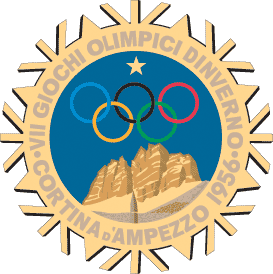
The 1948 Winter Olympics, officially known as the V Olympic Winter Games and commonly known as St. Moritz 1948, were a winter multi-sport event held from 30 January to 8 February 1948 in St. Moritz, Switzerland. The Games were the first to be celebrated after World War II; it had been twelve years since the last Winter Games in 1936.

The 1956 Winter Olympics, officially known as the VII Olympic Winter Games and commonly known as Cortina d'Ampezzo 1956, were a multi-sport event held in Cortina d'Ampezzo, Italy, from 26 January to 5 February 1956.

The 1964 Winter Olympics, officially known as the IX Olympic Winter Games and commonly known as Innsbruck 1964, were a winter multi-sport event which was celebrated in Innsbruck, Austria, from January 29 to February 9, 1964. The city was already an Olympic candidate, unsuccessfully bidding to host the 1960 Games. Innsbruck won the 1964 Games bid, defeating the cities of Calgary in Canada and Lahti in Finland. The sports venues, many of which were built for the Games, were located within a radius of 20 km (12 mi) around Innsbruck. The Games included 1,091 athletes from 36 nations, which was a record for the Winter Games at the time. Athletes participated in six sports and ten disciplines which bring together a total of thirty-four official events, seven more than the 1960 Winter Olympic Games. The luge made its debut on the Olympic program. Three Asian nations made their Winter Games debut: North Korea, India and Mongolia.

The 1988 Winter Paralympic Games were the fourth Winter Paralympics, held again in Innsbruck, Austria. These were the last Paralympics to be held in a separate location from the Olympics. Beginning in 1992, the Olympics and the Paralympics were held in the same city or in an adjacent city. These Paralympics were not held at the same Olympic venue in Calgary, Canada, because of financial and recruiting difficulties. A total of 377 athletes from 22 countries took part. The USSR competed for the first and only time. Sit-skiing was introduced as another event in both the Alpine and Nordic skiing competitions. Other sports were biathlon and ice sledge speed racing. Ice sledge speed racer Knut Lundstroem from Norway was the most successful athlete, winning four gold medals in the 100m, 500m, 1000m and 1500m events.

Nordic combined at the 1998 Winter Olympics, consisted of two events, held from 13 February to 20 February. The ski jumping portion took place at Hakuba Ski Jumping Stadium, while the cross-country portion took place at Snow Harp.
The Nordic combined event at the 1992 Winter Olympics consisted of two athletic disciplines, held from 11 February to 17 February. The ski jumping portion and the 15 km cross-country portion of the Nordic Combined event were both held at Courchevel-le Praz. A temporary cross-country stadium was constructed in a field directly adjacent (east) to the Tremplin du Praz ski jump outrun. All other cross-country and Biathlon competitions were held at Les Saisies.
Nordic combined at the 1980 Winter Olympics, consisted of one event, held from 18 February to 19 February. The ski jumping portion took place at Lake Placid Olympic Ski Jumping Complex, while the cross-country portion took place at Lake Placid Olympic Sports Complex Cross Country Biathlon Center.
Nordic combined at the 1984 Winter Olympics, consisted of one event, held from 11 February to 12 February. The ski jumping portion took place at Igman Olympic Jumps, while the cross-country portion took place at Igman.
Nordic combined at the 1972 Winter Olympics consisted of one event, held from 4 February to 5 February. The ski jumping portion took place at Miyanomori Ski Jump Stadium, while the cross-country portion took place at Makomanai Park.

Nordic combined at the 1994 Winter Olympics, consisted of two events, held from 18 February to 24 February. The ski jumping portion took place at Lysgårdsbakken, while the cross-country portion took place at Birkebeineren Ski Stadium.
Ski jumping at the 1988 Winter Olympics consisted of three events held from 14 February to 24 February, taking place at Canada Olympic Park. The Calgary Games featured the addition of a new event, the first program change since 1964, with the debut of the team event. Britain's Eddie "The Eagle" Edwards achieved celebrity by finishing last in both individual events, with less than half the points of the second-last competitor.
At the 1936 Winter Olympics, one individual Nordic combined event was contested. It was held on Wednesday, February 12, 1936 and on Thursday, February 13, 1936.
Nordic combined at the 1948 Winter Olympics consisted of one event, held from 31 January to 1 February. The ski jumping portion took place at Olympiaschanze St. Moritz, while the cross-country portion took place around the hills of St. Moritz.
Nordic combined at the 1956 Winter Olympics consisted of one event, held from 29 January to 31 January. The ski jumping portion took place at Trampolino Olimpico, while the cross-country portion took place at Lo Stadio della neve.
Nordic combined at the 1960 Winter Olympics consisted of one event, held from 21 February to 22 February. The ski jumping portion took place at Papoose Peak Jumps, while the cross-country portion took place at McKinney Creek Stadium.

The Nordic combined events have been contested at the Winter Olympic Games since 1924. The first competition involved 18 km cross-country skiing, followed by ski jumping.
At the FIS Nordic World Ski Championships 2009 in Liberec, Czech Republic, four Nordic combined were held. It also showed the biggest format changes since the introduction of the Gundersen method at the 1985 World Championships in Seefeld, Austria. In addition to the 10 km mass start event, there were changes in the Gundersen-based individual events. The 7.5 km sprint event was changed to a 10 km individual large hill event while the 15 km individual event was changed to a 10 km individual normal hill event with both being approved in September 2008. These changes also affected the Nordic combined program for the 2010 Winter Olympics in Vancouver though the mass start was excluded. The United States, which had two medals in Nordic combined prior to this championships, won a total of four medals with three golds and a bronze. Todd Lodwick, whose previous best individual finish at the world championships was 13th in the 7.5 km sprint at Oberstdorf in 2005, won golds in the 10 km mass start and 10 km individual normal hill events. His teammate Bill Demong won a gold in the 10 km individual large hill and bronze in the 10 km individual normal hill events. Germans Tino Edelmann and Björn Kircheisen each won a silver in the 4 x 5 km freestyle team event, then won individual silver medals in the 10 km mass start and 10 km individual large hills events, respectively. France's Jason Lamy Chappuis earned two bronze medals, earning them in the 10 km individual large hill and 10 km mass start. Norway's Jan Schmid won a silver in the 10 km mass start and a bronze in the 4 x 5 km freestyle event. A fourth American medal was prevented when Demong was disqualified in the ski jumping part of the 4 x 5 km freestyle team event for failing to wear his bib during competition, dropping the US to 12th and forcing their withdrawal from the cross country portion of the event. The Japanese won their first gold medal at the championships in the team event since 1995 when they edged the Germans in a photo finish. Current World Cup leader Anssi Koivuranta of Finland has a disappointing world championships, earning his best finish of fourth both in the 10 km individual normal hill and 10 km mass start events. Norway's Magnus Moan, second in the World Cup standings, also had a disappointing championships as well, with a best place finish of fifth in the 10 km individual large hill events even though he set the fastest cross-country skiing portion time in both the 10 km individual large hill and the 10 km individual normal hill events.
The men's individual normal hill/10 km Nordic combined competition for the 2010 Winter Olympics in Vancouver, Canada, was held at Whistler Olympic Park in Whistler, British Columbia, on 14 February.
The men's team large hill/4 x 5 km Nordic combined competition for the 2010 Winter Olympics in Vancouver, Canada was held at Whistler Olympic Park in Whistler, British Columbia on 23 February. The Austrian team of Michael Gruber, Christoph Bieler, Felix Gottwald, and Mario Stecher were the defending Olympic champions. Gruber retired after the 2007-08 season. Gottwald originally retired after the 2006-07 World Cup season, but came out of retirement in May 2009 to compete for the 2009-10 World Cup season including the 2010 Games. The defending world champions were the Japanese team of Yūsuke Minato, Taihei Kato, Akito Watabe, and Norihito Kobayashi. The last World Cup event prior to the 2010 Games in this format took place on 12 December 2009 in Harrachov, Czech Republic, but that event was cancelled on 4 December 2009 to warm weather and lack of snow. A team normal hill event took place prior to the 2010 Winter Games in Schonach, Germany on 24 January 2010 and was won by the German team of Georg Hettich, Eric Frenzel, Björn Kircheisen, and Tino Edelmann.
The men's individual nordic combined competition for the 1988 Winter Olympics in Calgary at Canada Olympic Park and Canmore Nordic Centre on 27 and 28 February.








